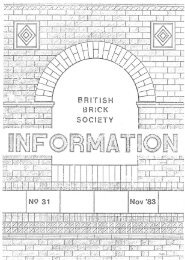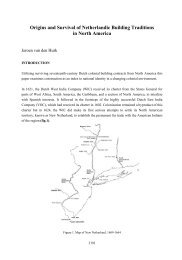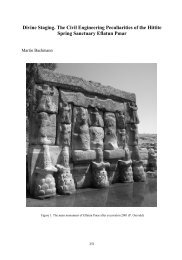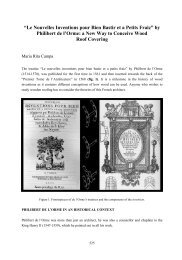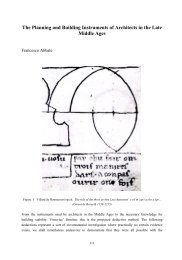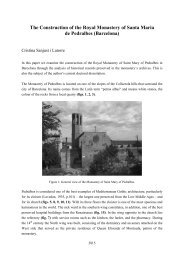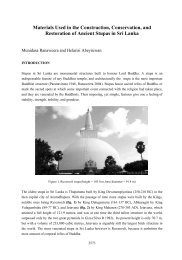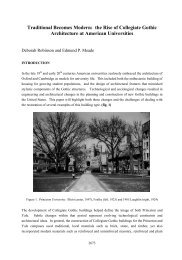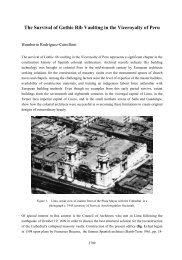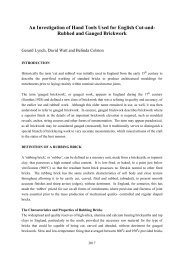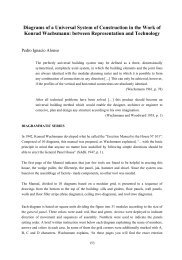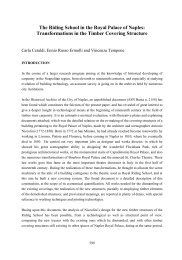Paul Bonatz and the Search for an Art - Department of Architecture
Paul Bonatz and the Search for an Art - Department of Architecture
Paul Bonatz and the Search for an Art - Department of Architecture
You also want an ePaper? Increase the reach of your titles
YUMPU automatically turns print PDFs into web optimized ePapers that Google loves.
each <strong>of</strong> <strong>the</strong> 70 overpasses <strong>of</strong> <strong>the</strong> Merritt Parkway got its own, extremely elaborated appear<strong>an</strong>ce. By<br />
doing so, Dunkelberger’s designs did not care about <strong>the</strong> construction <strong>of</strong> <strong>the</strong> edifices at all. There<strong>for</strong>e<br />
his work, though showing some up-to-date <strong>Art</strong> Deco <strong>for</strong>ms in some <strong>of</strong> <strong>the</strong> overpasses, still belonged<br />
to <strong>the</strong> tradition <strong>of</strong> <strong>the</strong> nineteenth century, when <strong>the</strong> architectural treatment <strong>of</strong> bridges was seen to be<br />
totally independent from <strong>the</strong> engineer’s structure.<br />
Looking <strong>for</strong> Solutions <strong>for</strong> <strong>the</strong> Reichsautobahn Overpasses<br />
Coming back to <strong>the</strong> work <strong>of</strong> <strong>Paul</strong> <strong>Bonatz</strong>, we discover that also in Germ<strong>an</strong>y things did not develop<br />
immediately as well as expected <strong><strong>an</strong>d</strong> Todt had to turn to <strong>Bonatz</strong> again. After a visit to <strong>the</strong> nearly<br />
completed section between Fr<strong>an</strong>kfurt <strong><strong>an</strong>d</strong> Darmstadt Todt wrote to <strong>Bonatz</strong> at <strong>the</strong> beginning <strong>of</strong> 1935<br />
that he was "shaken to <strong>the</strong> core by <strong>the</strong> bad architectural appear<strong>an</strong>ce <strong>of</strong> <strong>the</strong> numerous bridges, which<br />
now are sp<strong>an</strong>ning over <strong>the</strong> roadway" (BA Bln, R 4601/1489) (Fig.9). In order to finally get rid <strong>of</strong><br />
<strong>the</strong> problem with <strong>the</strong> overpasses, Todt suggested that <strong>Bonatz</strong> should provide a report about <strong>the</strong><br />
buildings <strong>of</strong> this section, which could serve as future assist<strong>an</strong>ce <strong>for</strong> <strong>the</strong> OBK:<br />
With your excellent way to treat <strong>the</strong> things, it surely will be possible to help essentially<br />
<strong><strong>an</strong>d</strong> not to raise at all a feeling <strong>of</strong> <strong>an</strong>noy<strong>an</strong>ce about <strong>the</strong> criticism.<br />
(ibid.)<br />
In fact <strong>the</strong> <strong>for</strong>mer civil engineer Todt seemed to be very <strong>an</strong>xious about <strong>the</strong> reactions <strong>of</strong> his engineers<br />
towards criticism from <strong>an</strong> architect, even if <strong>the</strong> situation <strong>of</strong> <strong>the</strong> overpasses was not everywhere as<br />
devastating as in Fr<strong>an</strong>kfurt. In particular <strong>the</strong> bridge department <strong>of</strong> <strong>the</strong> OBK in Stuttgart under <strong>the</strong><br />
direction <strong>of</strong> Karl Schaechterle already had to <strong>of</strong>fer some satisfying solutions <strong>for</strong> overpass structures.<br />
Especially Fritz Leonhardt’s experimental steel constructions, like his overpass at Jungingen,<br />
achieved with <strong>the</strong>ir light decks in a cellular construction (that later would be known as orthotropic<br />
slab) a slimness that so far was hardly known (Leonhardt 1998, pp. 54-5).<br />
As <strong>the</strong> solutions <strong>for</strong> steel bridges by <strong>the</strong> OBK Stuttgart were also seen by <strong>Bonatz</strong> to be absolutely<br />
satisfying (HStA Wi 485/396, p. 8), he only concentrated in overpasses made in rein<strong>for</strong>ced<br />
concrete. But Todt still seemed to be insecure about <strong>the</strong> reaction <strong>of</strong> <strong>the</strong> engineers in <strong>the</strong> different<br />
OBK. Even if <strong>Bonatz</strong>’ report was only delivered in 20 copies at <strong>the</strong> beginning <strong>of</strong> April 1935, Todt<br />
tried to point out in his <strong>for</strong>eword that it was not <strong>the</strong> goal <strong>of</strong> this expertise to show <strong>the</strong> engineers a<br />
sole path <strong>for</strong> bridge design:<br />
I know that two architects rarely are <strong>of</strong> <strong>the</strong> same opinion. It is <strong>the</strong> objective <strong>of</strong> this<br />
expertise, by me<strong>an</strong>s <strong>of</strong> a consistent point <strong>of</strong> view, to give <strong>an</strong> accomplished <strong>for</strong>m also to<br />
<strong>the</strong> subordinated buildings. The expertise regards <strong>the</strong> suggested solution not as <strong>the</strong> only<br />
one, but as one <strong>of</strong> <strong>the</strong> possible good solutions.<br />
(HstA Wi 485/396, p. 51)<br />
2148



